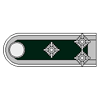Ok, kind of a slow start on this blog, but it seems to be picking up a bit now, I hope.
My planned display will include showing how the Churchill tank was re-fueled and re-armed. An unusual feature of the Churchill is that the fuel fillers are internal necessitating that the crew open up the rear gearbox compartment in order to "gas 'er up." Of course, the AFV Club kit does not have any internals, so to show the re-fueling operation, I will have to add the gearbox compartment details.
This means building these innards before closing up the hull, and there are some kit design elements that have to be worked around. I'll show some pics of what I've done to these below.
A particular issue is getting the air outlet area correctly detailed since it will be very visible with the gearbox compartment doors open.
So, for anyone who read the last post, here's the 5" air outlet conversion that I started on (before I realized that it was incorrect for the 8" air outlet on my model):

I had based this work on photos in Montgomery's book of his restoration. As I said earlier, he does not identify his Churchill as having the earlier, 5" air outlet.
After I had done most of this conversion to the inner rear hull plate, I noticed that as I was dry-fitting it, something wasn't right. More research and after re-visiting Shilito's "Armour in Focus" website, I realized what was wrong.
The inner rear hull plate with the three openings was used with the 5" air outlet design. It does look cool, and I had put a lot of thought into how to get the modification added seamlessly to the kit part. Oh well...
Now that I know what I'm looking for, there's a drawing in Fletcher's "Mr. Churchill's Tank" on page 33 (top) that shows the details of the 8" air outlet inner rear hull. Shilitto also has photos of this area on his website. The unmodified kit part is already pretty close to the correct design just requiring a slight lowering and the addition of three simple vertical stays to hold up the plates that form the gearbox compartment roof and the combing for the hatches.
So, with much anguish, I cut my neat 5" air outlet conversion apart...

I then lowered the level of the vertical rear plate. I'll add the three stays later in the conversion. After clean-up, the inner rear hull plate was ready to install.
In the mean time, I had to either add a layer of styrene to the rear hull side walls OR mill the forward side areas thinner. The step in thickness on the kit's inner rear hull sides is not correct (they should actually be the same thickness as their very ends).
Milling the kit side walls thinner was doable, but once the area is detailed and the gearbox roof, hatches, and hatch combings were installed, the correct thickness would be invisible to a viewer. So, the easier route of adding extra material to the sides to eliminate the step was the way I went.
I cut holes in these side pieces for the main brake drums. I then added them and filled the seams and sanded the sides to a uniform thickness in the gearbox compartment.
The main brake drums actually fit inside the final drives which are also contained inside the drive sprockets. However, only the inside faces of the brake drums are visible in the gearbox compartment. These were made with disks of styrene. Bolt detail was added around the edges of the brake-final drive holes.


I also added the circle of bolt heads for the gearbox lube drain access plate on the bottom of the hull and a thick styrene wall at the location where the engine and gearbox compartments are separated.
This wall will be used later to anchor the forward end of the fan and clutch as well as holding other details.

After these parts were ready, I glued up the lower hull according to step 10 in the instructions. I dry-fit the hull roof and upper hull glacis in order to keep everything nice and square for later. So the little bit of the hull roof visible in this photo is simply dry-fit in and held in place with the rubber band while the hull glue-up is drying.
Next on my list was to fabricate the two distinctive steering brakes with their cooling fins.
Basically, at this stage, I will scratch-build the gearbox (with the steering brakes). From there, I will add the clutch and fan. This will give me a unit that I can then use to space and align the gearbox mounts. I don't have any scaled drawings or plans of the gearbox, so everything has to be made using visual proportions and fitting the new parts into the existing kit area.
The first step in making the gear box is to make the steering brakes on either side of it. The thickness of these along with the "muff couplings" between the steering brakes and main brakes establishes the allowable width of the gearbox. So, steering brakes first...
Here are the parts for these:

I'm using stacks of .010 styrene disks alternating between two different diameters to create the cooling fins. These disks were cut from sheet styrene with a compass circle cutter, the center holes were drilled, and the disks were stacked on a Dremel tool metal cutoff disk screw holder.
I chucked this in a lath to turn each of the two diameters of disks to make them all even, but this operation could have also been done by turning the stacked disks against a sanding block using the Dremel. I turned one half of the disks to the large diameter, and then I turned the other half to the smaller diameter.
When stacked alternating from large to small, I came up with short cylinders with the cooling fin detail around them.
I also used the Dremel tool holder to get these stacks of disks concentric while gluing them up into their final configuration.
Here're a couple of shots of the steering brakes. They still need some clean-up after the glue dries and small holes will be drilled in the brake adjuster hole plugs. But, I think you can get the idea.


Next up will be the gearbox itself and some details added to replicate the hull bolting and assembly inside the compartment.
Once again, if any of the moderators happen to tune in, please correct the blog title to read AFV Club AF35153 "Churchill Mk.III" (i.e. add the "Churchill Mk.III" part).
Happy modeling!
 )
)
































































